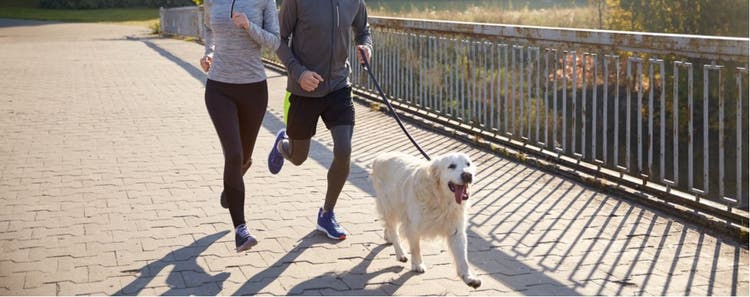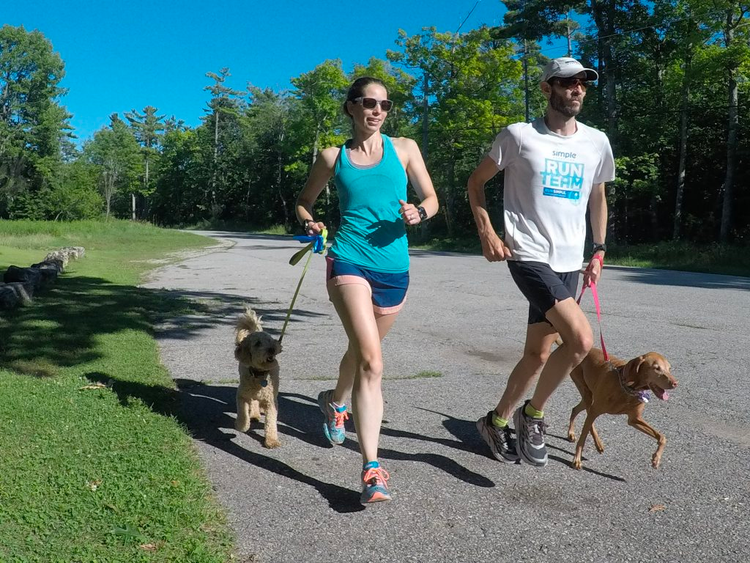
Running with Your Dog
Starting a running program can seem especially daunting when starting from scratch, but the emotional and health benefits gained make it worthwhile. Typically, starting with a partner is much easier, but finding that special someone to make the commitment can be tough. One partner that won’t let you down and keep you to your goals is your faithful dog. This loyal companion is usually ready, willing, and able to help you shed that holiday weight and stay fit during the summer months.
Before you grab your running shoes and a leash, keep these things in mind.
Pre-Run Preparation
Make sure to have your pup checked by their veterinarian before starting any exercise program. It is important to make sure your dog’s skeletal structure has matured enough to start a running program, as running before a dog’s growth plates have closed could create long-term damage to their long bones. Additionally, it is important to make sure your dog’s heart, lungs, and joints are healthy and sound before you start. Even young adult dogs can have abnormalities that would preclude them from participating in a running program. While we are on the subject, if you have not been regularly exercising yourself, it is a good idea for you to get a check-up as well (obviously from your personal doctor, and not the veterinarian).
Running Equipment

A pup wearing their running harness.
Fancy equipment isn’t necessary, but the following items are worth the investment.
- Leash. Your pet should ALWAYS be leashed when going on a run, both for their protection and for the protection of others. The only exception to this is if you are running with your pet in a remote area. Even the most obedient dog may suddenly want to have words with a squirrel, another dog, or person. In areas of high traffic, this could lead to tragedy or injury. A regular flat or webbing leash can certainly do the trick. Making the small investment in a running-specific leash is worth it, since these leashes have the ability to hook around your waist for hands-free running and often include a small section made of bungee cord to allow a little freedom. A retractable leash is NOT advised, as these can get wrapped up in your dog’s legs and cause serious injuries.
- Harness. You can certainly step out the door and go running with your dog’s regular collar, but investing in a sturdy harness is worth the money. If your dog likes to run ahead of you or suddenly decides to jet off to chase a squirrel, a neck harness can put undue pressure on their windpipe and cause choking. Many available harnesses have clips on the front and the back, making it easier to control your dog should they decide to suddenly run in a different direction. If you do decide to use a harness, make sure that it fits properly and your dog is not getting chaffed on longer runs.
- Cold Weather Gear. During the winter months, some dogs may need a little extra protection, especially if they have a thin or short coat. Many companies sell fleece and fleece-lined jackets that provide an extra layer on cool days without impeding running. It is important to note that some dogs need extra paw protection from salt and ice. Booties with grip or latex booties from PawZ® and protective wax from Musher’s® can provide paw protection from the harsh terrain.
- Hydration. Panting is a dog’s way of releasing heat to stay cool, but this also leads to evaporation of fluids. It’s always a good idea to carry water and a small collapsible bowl with you on long runs, so that you can keep your pet adequately hydrated.
Ready! Set! Run!
While your dog may seem far more energetic than you, they may not be in good running shape. So, whether you are a seasoned marathoner or a couch to 5k runner, it is imperative that you start your dog’s running program at a slow pace. Be sure to start your run with a 5-minute walking warm-up, which allows time for sniffing and emptying the bladder. Next, transition into 1 – 2 minute intervals of running, followed by 1 minute periods of walking. After a total of 15 minutes, transition into a cool down period.
Do this every other day, since your dog needs recovery time. After a week or two, increase the run/walk interval post-warm-up to 2 minutes of running and one minute walking for 15 – 20 minutes. Again, make sure to leave a day for recovery between runs. If your dog is doing well with this program, increase your run/walk ratio to add in slightly more running before walk breaks and slowly increase total running time. Keep the 10% rule in mind, which recommends not increasing weekly mileage/total time by more than 10%, in order to prevent possible injury. Also, always warm up and cool down with a walk. Afterwards, pamper your dog with a post-run massage.
Monitoring Your Dog
Dogs want to make their owners happy and will do almost anything to please their pack leader. You must always be vigilant when watching for signs of fatigue or discomfort, since dogs are likely to ignore these signs or be unaware that they are in pain.
Signs that your dog is tiring or injured include:
- Falling behind during a run
- Bobbing of the head or favoring of a leg
- Stopping altogether
If any of the above occur, take a walk break and try again a bit later. If your pup is still showing signs, then it is best to call it a day and walk home for some belly rubs on the couch.
Weather Considerations

Be sure to consider temperature when out for a run.
Dogs do not have the ability to cool down by the evaporation of sweat, since they lack sweat glands with the exception of those on their paw pads. Instead, dogs rely on panting to cool down, which makes them unable to tolerate the heat as efficiently as humans. Consequently, your dog is at greater risk for heat stroke and/or dehydration during warm weather.
Before heading out for a run with your dog, it is important to check both the temperature and the dew point values. The dew point is the level at which the air is saturated with water. A good guideline to follow is to add together the temperature in degrees Fahrenheit with the dew point level. If this value is equal or greater than 130, then you should avoid taking your pup for a run, since their ability to cool down and obtain oxygen from the moisture-saturated air will be compromised. Note that 130 is a general guideline, since some more heat-adapted breeds may be tolerant, while other Northern-type breeds (like Siberian Huskies) and brachycephalic breeds (like French Bulldogs) may be unable to tolerate a value over 110.
Even if the temperature, taking dew point into account, is appropriate, it is still advisable in the summer months to choose the cooler hours of the day to head out, either in the early morning or later in the evening. Carry water or run a route that has access to fountains. Consider routes with shade and potential access to pet-friendly open water for cooling down with a swim if necessary.
Always be on the lookout for signs of heat stroke and exhaustion, which include:
- Dark red “injected” gum and tongue color
- Excessive panting/tongue hanging out of the side of the mouth
- Weak/limp body
- Vomiting/bloody diarrhea
- Seizures
- Fainting
Should you notice early signs – stop running, take a break, and pour water on your pup’s paws, armpits, and inner thigh to try and cool them down. Should more serious signs occur (seizures, limp body, vomiting, diarrhea, or fainting) go immediately to your veterinarian as heat stroke can be fatal.
Avoid Harsh Running Surfaces
While you may be running in your old-school sneaks or donning the latest tech in running shoes, it is important to be mindful that your dog does not have the same added protection and cushioning. If your dog spends most of their time inside, their paw pads are likely to be soft and not as adapted to the abrasive effects of running on cement and pavement. In addition to building cardiovascular endurance, make sure to give your dog time to toughen up their pads.
After each run, examine their pads for wear, abrasions, and cuts. Consider running in an area that allows your dog to run alongside you on the grass or hit the trails for some softer surfaces. As the pads toughen, you can increase the time you spend running. If you do notice a cut or a deep abrasion, get your dog examined by their veterinarian. It is also important to note that on hot days, the temperature of the pavement increases as the surface heats up from the sun. Hot pavement can cause painful burns on the paws, so be sure to feel the temperature of the ground – if it is too hot for you to hold the back of your hand on it for 10 seconds, then it can potentially burn your furry friend’s paw pads.
Breed Considerations
A Border Collie can run circles around you for days, whereas a Chihuahua would rather sit on your lap than run around a track. When considering running with your dog, do take their breed into consideration, since each was originally created for a specific purpose. Breeds like Vizslas were bred for endurance, so they are likely to be able to handle longer runs. The Greyhound, while a great runner, is best suited for shorter distances. Short-nosed Brachycephalic breeds (like Pugs) are not well suited for running, since their facial characteristics are usually paired with narrowed nares (nostrils) and breathing issues, in addition to joint problems.
Running with your dog can be a fun bonding activity that promotes both emotional and physical health. As long as proper precautions are taken, it can be an activity you both enjoy… for the long run!